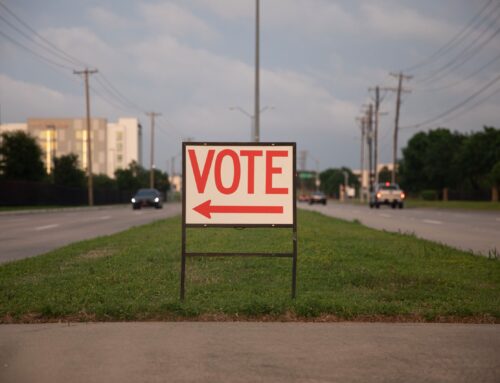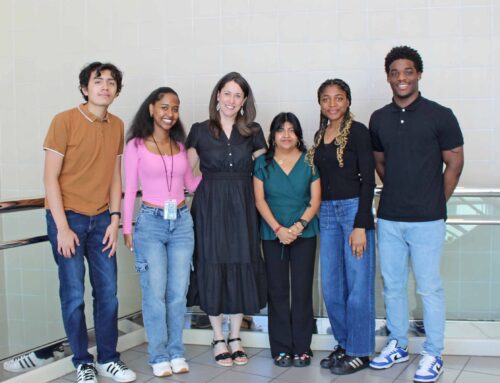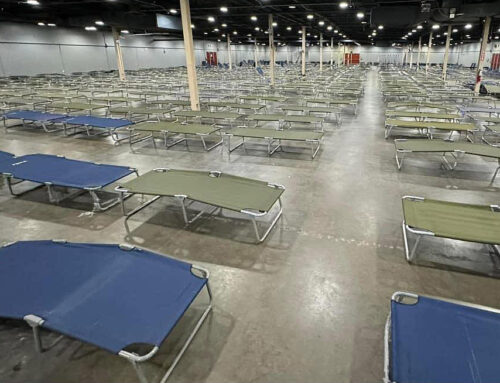We’ve been arguing for months about a parkway, where it will be located, how many lanes and exits it will or won’t have, and whether we need it to solve downtown’s traffic woes.
But while we’re at it, there’s something else we should be arguing about, too: What about the park? What about the sailboats and the waterspouts from those 1998 election fliers?
The Nov. 6 referendum offers a choice about a road – but ultimately, what difference does it make where the road is built if the park it’s supposed to be disrupting isn’t going to be much of a park after all?
If we’re looking for an argument worth having, the park is where we should start.
IN THE BEGINNING
It all begins with an after-the-fact disagreement, a fight over a word. Just what did the city of Dallas mean when the word “parkway” was penned into the 1998 bond proposition for the Trinity River Corridor Project?
In one corner – top-heavy with pro-road business leaders and lots of city, state and federal officials – the consensus is that “parkway” has always meant “tollroad,” and that in 1998, we knew we were voting for a six- to eight-lane tollroad built inside the levees.
In the other corner, led by Councilwoman Angela Hunt and backed by a grassroots campaign, the prevailing belief is that “parkway” doesn’t mean a high-speed, money-collecting interchange built in a floodway, and to suggest so is nothing more than deception.
Hunt’s TrinityVote campaign collected 80,000-plus signatures from registered voters, ensuring a vote on what kind of road we want to build inside the levees. Defeat of the referendum will allow a high-speed tollroad with no ramps into the park; approval of the referendum will force a redesign of the project, limiting construction inside the levees to a four-lane road with a 35 miles per hour speed limit.
This referendum, however, doesn’t ask opinions or make promises about the size and look of the Trinity River park and recreational facilities.
But the park is the major bone of contention for Hunt and her supporters, and they say the current tollroad design severely handicaps the park’s size and amenities and doesn’t allow the promised easy access.
It’s a park issue, they say.
The project’s supporters, with former Councilman Craig Holcomb as their point man, say that plenty of room will be left for a high-quality park with lots of ways to reach it – we’ll receive exactly what we voted for in 1998.
In fact, Holcomb’s group says the tollroad is the linchpin in a master plan designed to unclog the downtown mixmaster/canyon where I-30, I-35 and Central Expressway come together. Plus, it will help reduce pollution caused by all of those vehicles idling during rush hour.
It’s a road issue, they say.
The referendum will determine which side is right.
SAILBOATS AND LAKES
Rebecca Dugger can churn out all kinds of information about the Trinity park’s features, which is fitting considering she has been director of the City of Dallas’ Trinity River Corridor Project since 1999.
But she seems to be one of the few people in Dallas with this kind of detailed knowledge.
Holcomb, after shuffling through papers and computer files for a minute or two, referred specific questions about the park to Dugger.
Even Hunt, whose arguments against the tollroad are largely based on the park, has more to say about how much land the tollroad will take away from the park than what the park’s possibilities would be if the tollroad were downsized.
A quick search last month through the frequently asked questions on both sides’ websites revealed no specifics about the proposed lakes or amenities. So when TrinityVote supporters talk about a “world-class park and recreational facility,” what are they talking about? How big will the park be, and what is it going to look like?
That depends on who’s talking.
Those in the pro-tollroad camp (whose slogan when Hunt launched her petition campaign was “Sink the Petition! Save the Trinity!”) talk about 10,000 acres when referring to the Trinity parkland. That’s more than 10 times the size of New York’s Central Park in an area that stretches from Interstate 20 southeast of downtown to north of I-35 and Walnut Hill Lane in North Dallas.
Most of this acreage, however, won’t be developed and designed into a bigger and better version of White Rock Lake Park. The 10,000-acre figure measures everything from levee to levee and encompasses everything in between – including the tollroad.
A little more than half of the land would be devoted to the Great Trinity Forest, the project’s southern sector running from I-20 to the 8th and Corinth DART rail station. The idea is to leave most of this land in its natural state. The only new construction here, funded partly with $41 million from the 1998 bond campaign, is hiking, biking and walking trails, an equestrian center, and an Audubon interpretive center built along an old landfill, “so you know what the birds and trees you’re seeing actually are,” says Holcomb, who is executive director of the Trinity Commons Foundation.
Another one-fifth of the land, stretching from Westmoreland to I-35 and Royal, would be used to build a $30 million, 200-acre, 22-field soccer complex off the interstate and along Walnut Hill (part of this complex also will sit on a former landfill). Roughly $13 million to purchase the land came from the 1998 bond election; the remaining $17 million will come from the 2003 and 2006 city bond elections, Dugger says.
That leaves about 2,000 acres between Westmoreland and the DART station for the downtown river, levees, lakes and park, which is what most of us associate with the artist’s renderings on campaign brochures leading up to the 1998 bond election.
More than half of that area would be what Dugger calls “unprogrammed – where you go throw a Frisbee or run your dog.” Roughly 835 acres – an area slightly larger than Central Park and slightly smaller than White Rock Lake and park – would be “programmed,” or designed, she says, using another $31 million from the 1998 bond election. Additionally, a small kayak-accessible adventure course will be built, along with some meandering canoe-appropriate offshoots, Dugger says. (For a complete list of amenities to be built in the park, see the adjacent sidebar on page 45.)
Then there are the two lakes.
An “urban lake” will be built near downtown, separated from the central city by the tollroad, a floodwall and a 100-foot-wide promenade running next to the edge of the lake, Dugger says. This lake starts just upstream of Continental and stretches to I-30.
A “natural lake” will be built near the wetlands and will have a softer edge, she says. This lake would stretch from I-30 to the other side of I-35.
The urban lake will include 80 acres of water, and the natural lake will have 60 acres of water, Dugger says. By way of comparison, White Rock has 1,015 acres and Bachman has 205 acres.
That’s not much navigation room for the sailboats pictured in the 1998 brochures, according to Hunt’s group. To illustrate their point, TrinityVote has seized on a remark Holcomb made in February to the City Council’s Trinity River Committee meeting:
“Some of the material showed sailboats,” Holcomb said at the time. “There may not be a sailboat. But that’s the way it is.”
Eight months later, Holcomb is basically saying the same thing, but he’s using more precise language.
“As with so many things on this project, it depends on how you define sailboat,” he says today. “A sailboat that can win the America’s Cup? No. A Sunfish? Yes.”
A ROAD TOO FAR?
Originally, the 10-mile-long tollroad was designed to be right up against the levee walls of the Trinity, where planners figured it would be somewhat removed from flooding while leaving the largest amount of floodway available for parkland development.
Shortly after Hurricane Katrina breached the New Orleans levees and sent water tearing through the city, however, the U.S. Army Corps of Engineers determined that building a tollroad into the sides of a levee wall constituted a serious flooding issue for the roadway and added to the risk of a levee breach in Dallas. So planners ordered the tollroad moved 50 feet farther into the river’s basin – cutting into a portion of the land set aside for the park.
During council briefings on the matter, Hunt – who had been appointed to the council committee overseeing the Trinity project – determined that the relocated roadway would eat up about one-third of the acreage originally planned for the downtown Trinity park. Soon afterward, the TrinityVote petition campaign began.
Whether or not land was “lost” is a matter of semantics, Dugger says. It’s true that shifting the tollroad takes away roughly 45 acres of the downtown parkland between the river and the Oak Cliff levees. But the “island,” the land in the middle of the park bordered by the lakes or river on all sides, gained 30 acres, she says.
“When you look at the grand scheme of things, it’s not a lot,” Dugger says of the acreage lost.
Of course the grand scheme is, in essence, the problem, Hunt says. For her, the case against the tollroad is partly about the parkland it eats up. But the debate also is about building a Central Park-esque signature recreational area abutting downtown.
“This isn’t about numbers. They’re playing a numbers game rather than having a bold vision for our city, and that’s where we really differ,” Hunt says. “They continue to represent the interests of those who have a vested financial interest by building the tollroad in our park.”
It’s not that TrinityVote wants to add any particular amenity to the parkland that the tollroad would eliminate. Restaurants and shops aren’t even a possibility, Hunt says, because the project is being built in a floodway. Also, she acknowledges that voting against the tollroad won’t necessarily free up any funds for extra park projects.
Instead, TrinityVote supporters want to reclaim the green space inside the levees on which the tollroad will be built. She and her group envision something like Town Lake (recently renamed Lady Bird Lake) on the edge of Austin’s downtown.
“Having a tollway cutting through the heart of the park destroys any chance of it becoming the recreational dream we envisioned,” says John Loza, a councilman from 1997-2005. Loza says he supported the 1998 bond proposition because it was cast as a transforming project, but he has since rethought his support, believing the current plan “defeats the purpose of the project and isn’t good for the city of Dallas.”
Loza says TrinityVote supporters aren’t necessarily against a road near the park; they just believe its impact on parkland should be minimized. Their idea: Restrict any kind of road inside the levees to a 35-mph meandering street with direct park access, or go ahead and build the high-speed tollroad, but build it along Industrial Boulevard outside the Trinity levees.
Both ideas miss the point, supporters of the current plan say. It’s difficult to talk about the park as a separate entity, says Holcomb, because the people who have been working on the park for the past decade consider all of the different parts – flood control, economic development, traffic, recreation – as parts of a whole.
For tollroad supporters, the Trinity project is less about a park and more about improving downtown’s transportation mess and building the infrastructure necessary to allow Dallas to continue growing. They believe building the tollroad inside the levees will help relieve congestion in the mixmaster/canyon area south of downtown, which has been described by transportation officials and City Council members as one of the major choke points not only in North Texas but in the entire country.
The Trinity tollroad as currently planned has “a more sensitive design with urban features, more curves,” says Michael Morris, director of transportation for the North Central Texas Council of Governments.
“Think Central Expressway along the Trinity River,” Morris says.
And though the Corps of Engineers demanded the road be moved farther into the floodway, it does leave some greenspace near the north levee so that “100,000 vehicles will have a better driving experience,” Holcomb says.
Of course, imagining Central Expressway inside the Trinity River levees – which separate the park from downtown – is a nightmarish vision for TrinityVote supporters.
But that’s not the way Dugger sees it.
“Look at Dallas globally,” Dugger says. “It’s about transportation. It’s not park versus road. It’s not either-or. That’s not the question.
“It’s just where we’ve got to have this road, and this is where it needs to be to get it done in the most balanced way possible.”
The only other option on the table would be a reliever route/tollroad along Industrial Boulevard, Dugger says. Industrial Boulevard, a street that lives up to its name, is lined with liquor stores, fast-food joints and bail bond shops, and its two most notable tenants are the SPCA (which is moving soon) and the ever-expanding Lew Sterrett Justice Center.
To construct the road there, she says, would require acquiring roughly 800 parcels of property with 250 to 300 structures, mostly businesses.
The additional cost of that roadway would be enormous, Dugger says. Many of the parcels would probably have to be acquired through eminent domain (where the government uses courts to acquire property by force), she says, resulting in at least a five-year delay. Right now, the tollroad is estimated to cost between $900 million and $1 billion, but if it’s built along Industrial, the cost would be $1.5 billion to $1.9 billion, Dugger says.
Hunt says she understands the problems and additional expenses caused by making changes to the current plans, but says she believes that ultimately, the city’s need for a signature park trumps the need for another road.
“Dallas has few natural assets. We aren’t hilly. We don’t have a large lake in Dallas. Too often, people don’t think of Dallas as a city with a lot of natural beauty,” Hunt says.
“We’ll build many new highways in the city of Dallas but only one Trinity Park, and we have only one opportunity to get it right. Simply by virtue of putting this road in, we’re ruining our singular, our only opportunity to create a world-class facility.”
SO NOW WHAT?
If the referendum passes, and the roadway inside the levees is reduced to speeds of no more than 35 mph, tollroad supporters say it could be the beginning of the end for the entire Trinity River Corridor Project.
Holcomb’s Trinity Commons Foundation website says the referendum itself – no matter the result – “could potentially kill the whole redevelopment project.” Dugger says that some funding would be immediately in question, and future money would be more difficult to attain.
For example, the North Texas Tollway Authority (NTTA) agreed to foot the $25 million bill to dig out the lakes because it plans to use the dirt to raise the tollroad embankments above the 100-year flood plain, Dugger says.
If the referendum fails and that money goes away, the Corps of Engineers could step in and help fund the lake digging, Dugger says. But the Corps is more likely to propose a 65/35 or 50/50 split of the cost, she says, so “the city would have to pony up something” in order to complete the two lakes near downtown; the original $31 million approved in the 1998 bond issue won’t be enough. The city already has spent $8 million of that money on design, Dugger says, so the $23 million left wouldn’t even cover the cost of digging the lakes, according to NTTA’s estimate.
Other potential lost funding would have more to do with constructing the tollroad than building the park, such as $10 million pledged by the Regional Transportation Commission for a “deck park” that would allow pedestrian access to the park from Reunion Boulevard via a bridge extending across the tollroad and down into the floodway.
Current plans also include NTTA’s promise to spend $5 million for five ramps extending down into the park from existing bridges that span the Trinity River – Hampton, Sylvan, Houston-Jefferson, Corinth and Martin Luther King Jr., Dugger says. (The park could also be accessed from some pedestrian routes on the Oak Cliff side of the river, she says.)
Neither of these projects would be necessary if, as TrinityVote argues, the corridor project was designed with exits from the parkway directly into the park.
Then there’s the $6 million Dallas County pledged for the design of an I-30 signature bridge, contingent on building a tollroad that would carry the required capacity to act as a reliever route, Dugger says. Already there have been rumblings from county commissioners about wanting their money back if the referendum passes.
“So if we don’t do a Trinity Parkway at all, I don’t know if Dallas County is going to come knocking for their money,” she says.
“And we’ve already spent about $4 million of that – oops.”
Whether the Trinity Parkway inside the levees is built as a tollroad or a four-lane, 35-mph roadway, however, won’t affect the Great Trinity Forest improvements or completion of the soccer complex, Dugger says.
“All the stuff upstream and downstream, that’s all a go,” Dugger says.
And ultimately, how and where the Trinity Parkway is built may not even affect the downtown park, she says. The park’s construction would be delayed again, she says, because it has been designed around a tollroad built within the levees; tossing that plan out would require the city to rethink and redesign the lakes and everything else in the park.
The last time that happened – when former Mayor Laura Miller asked to review the project – it took a year and a half to redo. But Dugger says the death of a tollroad inside the levees won’t mean the death of the adjacent park.
“I believe it can be done,” Dugger says.
IT’S UP TO US NOW
When it comes right down to it, the real divide between the two sides isn’t about speed limits or park access points. It’s not even about the definition of the word “parkway” (at least not anymore).
The real divide is between people who see the Trinity River Corridor Project as a project about a park, and people who see it as a project about a road.
On Nov. 6, we’ll make the decision.





